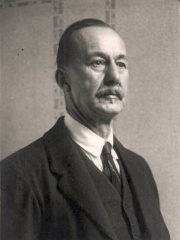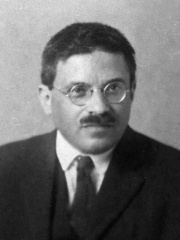
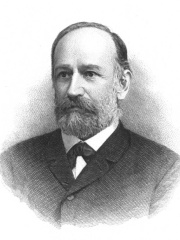
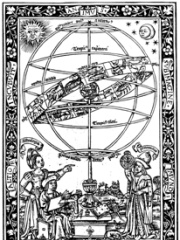
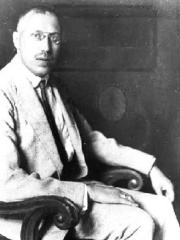
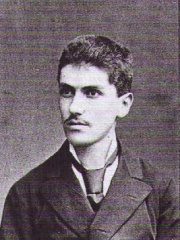
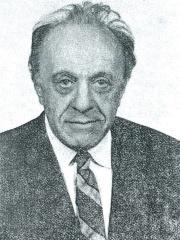

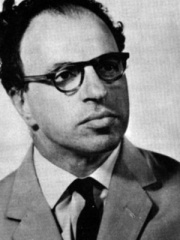
The Most Famous
MATHEMATICIANS from Austria
This page contains a list of the greatest Austrian Mathematicians. The pantheon dataset contains 1,004 Mathematicians, 17 of which were born in Austria. This makes Austria the birth place of the 13th most number of Mathematicians behind India, and China.
Top 10
The following people are considered by Pantheon to be the top 10 most legendary Austrian Mathematicians of all time. This list of famous Austrian Mathematicians is sorted by HPI (Historical Popularity Index), a metric that aggregates information on a biography’s online popularity. Visit the rankings page to view the entire list of Austrian Mathematicians.

1. Paul Ehrenfest (1880 - 1933)
With an HPI of 65.10, Paul Ehrenfest is the most famous Austrian Mathematician. His biography has been translated into 41 different languages on wikipedia.
Paul Ehrenfest (18 January 1880 – 25 September 1933) was an Austrian theoretical physicist who made major contributions to the field of statistical mechanics and its relations with quantum mechanics, including the theory of phase transition and the Ehrenfest theorem. He befriended Albert Einstein on a visit to Prague in 1912 and became a professor in Leiden, where he frequently hosted Einstein. He died by murder-suicide in 1933; he killed his disabled son Wassik, and then himself.

2. Josef Stefan (1835 - 1893)
With an HPI of 63.94, Josef Stefan is the 2nd most famous Austrian Mathematician. His biography has been translated into 49 different languages.
Josef Stefan (Slovene: Jožef Štefan; 24 March 1835 – 7 January 1893) was a Carinthian Slovene physicist, mathematician, and poet of the Austrian Empire.

3. Georg von Peuerbach (1423 - 1461)
With an HPI of 60.55, Georg von Peuerbach is the 3rd most famous Austrian Mathematician. His biography has been translated into 32 different languages.
Georg von Peuerbach (also Purbach, Peurbach; Latin: Purbachius; born May 30, 1423 – April 8, 1461) was an Austrian astronomer, poet, mathematician and instrument maker, best known for his streamlined presentation of Ptolemaic astronomy in the Theoricae Novae Planetarum. Peuerbach was instrumental in making astronomy, mathematics and literature simple and accessible for Europeans during the Renaissance and beyond.

4. Hans Hahn (1879 - 1934)
With an HPI of 57.73, Hans Hahn is the 4th most famous Austrian Mathematician. His biography has been translated into 29 different languages.
Hans Hahn (German: [haːn]; 27 September 1879 – 24 July 1934) was an Austrian mathematician and philosopher who made contributions to functional analysis, topology, set theory, the calculus of variations, real analysis, and order theory. In philosophy he was among the main logical positivists of the Vienna Circle.
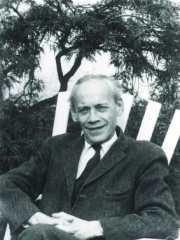
5. Emil Artin (1898 - 1962)
With an HPI of 57.66, Emil Artin is the 5th most famous Austrian Mathematician. His biography has been translated into 35 different languages.
Emil Artin (German: [ˈaʁtiːn]; March 3, 1898 – December 20, 1962) was an Austrian mathematician of Armenian descent. Artin was one of the leading mathematicians of the twentieth century. He is best known for his work on algebraic number theory, contributing largely to class field theory and a new construction of L-functions. He also contributed to the pure theories of rings, groups and fields. Along with Emmy Noether, he is considered the founder of modern abstract algebra.

6. Georg Alexander Pick (1859 - 1942)
With an HPI of 56.76, Georg Alexander Pick is the 6th most famous Austrian Mathematician. His biography has been translated into 24 different languages.
Georg Alexander Pick (10 August 1859 – 26 July 1942) was an Austrian Jewish mathematician who was murdered during The Holocaust. He was born in Vienna to Josefa Schleisinger and Adolf Josef Pick and died at Theresienstadt concentration camp. Today he is best known for Pick's theorem for determining the area of lattice polygons. He published it in an article in 1899; it was popularized when Hugo Dyonizy Steinhaus included it in the 1969 edition of Mathematical Snapshots. Pick studied at the University of Vienna and defended his Ph.D. in 1880 under Leo Königsberger and Emil Weyr. After receiving his doctorate he was appointed an assistant to Ernst Mach at the Charles-Ferdinand University in Prague. He became a lecturer there in 1881. He took a leave from the university in 1884 during which he worked with Felix Klein at the University of Leipzig. Other than that year, he remained in Prague until his retirement in 1927 at which time he returned to Vienna. Pick headed the committee at the (then) German university of Prague, which appointed Albert Einstein to a chair of mathematical physics in 1911. Pick introduced Einstein to the work of Italian mathematicians Gregorio Ricci-Curbastro and Tullio Levi-Civita in the field of absolute differential calculus, which later in 1915 helped Einstein to successfully formulate general relativity. Charles Loewner was one of his students in Prague. He also directed the doctoral theses of Josef Grünwald, Walter Fröhlich, and Saly Struik. Pick was elected a member of the Czech Academy of Sciences and Arts, but was expelled after Nazis took over Prague. After retiring in 1927, Pick returned to Vienna, the city where he was born. After the Anschluss when the Nazis marched into Austria on 12 March 1938, Pick returned to Prague. In March 1939 the Nazis invaded Czechoslovakia. Pick was sent to Theresienstadt concentration camp on 13 July 1942. He died there two weeks later.

7. Karl Menger (1902 - 1985)
With an HPI of 55.50, Karl Menger is the 7th most famous Austrian Mathematician. His biography has been translated into 24 different languages.
Karl Menger (January 13, 1902 – October 5, 1985) was an Austrian–American mathematician, the son of the economist Carl Menger. In mathematics, Menger studied the theory of algebras and the dimension theory of low-regularity ("rough") curves and regions; in graph theory, he is credited with Menger's theorem. Outside of mathematics, Menger has substantial contributions to game theory and social sciences.

8. Philipp Frank (1884 - 1966)
With an HPI of 55.01, Philipp Frank is the 8th most famous Austrian Mathematician. His biography has been translated into 23 different languages.
Philipp Frank (March 20, 1884 – July 21, 1966) was a physicist, mathematician and philosopher of the early-to-mid 20th century. He was a logical positivist, and a member of the Vienna Circle. He was influenced by Mach and was one of the Machists criticised by Lenin in Materialism and Empirio-criticism.

9. Hermann Bondi (1919 - 2005)
With an HPI of 52.13, Hermann Bondi is the 9th most famous Austrian Mathematician. His biography has been translated into 34 different languages.
Sir Hermann Bondi (1 November 1919 – 10 September 2005) was an Austrian-British mathematician and cosmologist. He is best known for developing the steady state model of the universe with Fred Hoyle and Thomas Gold as an alternative to the Big Bang theory. He contributed to the theory of general relativity, and was the first to analyze the inertial and gravitational interaction of negative mass and the first to explicate correctly the nature of gravitational waves. In his 1990 autobiography, Bondi regarded the 1962 work on gravitational waves as his "best scientific work".: 79
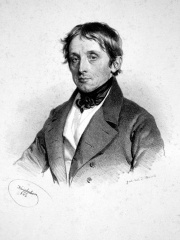
10. Simon von Stampfer (1790 - 1864)
With an HPI of 51.69, Simon von Stampfer is the 10th most famous Austrian Mathematician. His biography has been translated into 18 different languages.
Simon Ritter von Stampfer (26 October 1792 (according to other sources 1790)), in Windisch-Mattrai, Archbishopric of Salzburg today called Matrei in Osttirol, Tyrol – 10 November 1864 in Vienna) was an Austrian mathematician, surveyor and inventor. His most famous invention is that of the stroboscopic disk which has a claim to be the first device to show moving images. Almost simultaneously, a similar device was developed in Belgium (the phenakistiscope).
People
Pantheon has 17 people classified as Austrian mathematicians born between 1423 and 1921. Of these 17, none of them are still alive today. The most famous deceased Austrian mathematicians include Paul Ehrenfest, Josef Stefan, and Georg von Peuerbach. As of April 2024, 1 new Austrian mathematicians have been added to Pantheon including Wilhelm Wirtinger.
Deceased Austrian Mathematicians
Go to all RankingsPaul Ehrenfest
1880 - 1933
HPI: 65.10
Josef Stefan
1835 - 1893
HPI: 63.94
Georg von Peuerbach
1423 - 1461
HPI: 60.55
Hans Hahn
1879 - 1934
HPI: 57.73
Emil Artin
1898 - 1962
HPI: 57.66
Georg Alexander Pick
1859 - 1942
HPI: 56.76
Karl Menger
1902 - 1985
HPI: 55.50
Philipp Frank
1884 - 1966
HPI: 55.01
Hermann Bondi
1919 - 2005
HPI: 52.13
Simon von Stampfer
1790 - 1864
HPI: 51.69
Friedrich Waismann
1896 - 1959
HPI: 50.34
Hilda Geiringer
1893 - 1973
HPI: 49.95
Newly Added Austrian Mathematicians (2024)
Go to all RankingsOverlapping Lives
Which Mathematicians were alive at the same time? This visualization shows the lifespans of the 16 most globally memorable Mathematicians since 1700.



